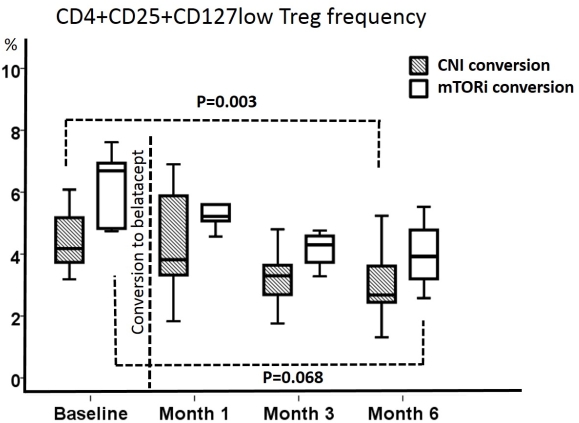Lower Frequency of Regulatory T-Cells After Conversion from CNIs or mTORi to Belatacept in a Prospective Matched Controlled Study in Renal Allograft Recipients
Nephrology, Charité
Universitätsmedizin Berlin, Berlin, Germany.
Meeting: 2015 American Transplant Congress
Abstract number: D11
Keywords: Co-stimulation, Lymphocytes, Proliferation
Session Information
Session Name: Poster Session D: Costimulation and Signaling in Lymphocytes
Session Type: Poster Session
Date: Tuesday, May 5, 2015
Session Time: 5:30pm-6:30pm
 Presentation Time: 5:30pm-6:30pm
Presentation Time: 5:30pm-6:30pm
Location: Exhibit Hall E
Objective: Regulatory T-cells (Tregs) are considered to play a crucial role in maintaining control of immune response following renal transplantation (Tx). So far, only limited data are available from prospective controlled trials on the time course and frequency of Tregs after conversion from either Calcineurin inhibitors (CNIs) or mammalian target of Rapamycin inhibitors (mTORi) to Belatacept, a co-stimulatory blocker of CD80/86. The aim of this study was to evaluate the influence of belatacept on T-cell subsets with focus on Tregs after withdrawal from CNI or mTORi.
Methods: 20 renal transplant patients (pts) on either CNIs (n=10) or mTORi (n=10), who had intolerability of their maintenance regimen participated in a prospective controlled 12-month trial. Conversion from CNI or mTORi to belatacept was performed in a stepwise manner over a 4-week period. Characterization of T-cell subsets and Treg phenotype was performed at baseline, month (Mo) 1, 3 and 6, respectively. Peripheral blood mononuclear cells were analyzed with multi-color flow cytometry using antibodies against CD3/8/4/25 and CD127. Additionally, we isolated CD4CD25Tregs and co-cultured them with CD4 effector cells (Teffs) to evaluate their suppressive capacity.
Results: Actually, 15 pts passed interim analysis 6 Mo after conversion to belatacept. At 3 Mo, frequency of CD4+CD25+CD127low Treg decreased in CNI and mTORi withdrawal groups. In addition, Tregs dropped to their minimum 6 Mo after conversion (CNI 2.9%; p=0.003; mTORi 4%; p=0.068,  ). Despite reduced Treg numbers after conversion to belatacept, the suppressive function of Tregs was not impaired when Teffs are co-cultured with Tregs 1:1 (CNI-group: BL=33%, Mo3=31%, Mo6=20%; p=0.11)(mTORi-group: BL=27%, Mo3=24%, Mo6=19%; p=0.4).
). Despite reduced Treg numbers after conversion to belatacept, the suppressive function of Tregs was not impaired when Teffs are co-cultured with Tregs 1:1 (CNI-group: BL=33%, Mo3=31%, Mo6=20%; p=0.11)(mTORi-group: BL=27%, Mo3=24%, Mo6=19%; p=0.4).
Conclusion: The present study demonstrated a decrease of Treg frequency after conversion from either CNI or mTORi to belatacept. Despite lower Treg frequencies, suppressive Treg function was not restricted under belatacept therapy. These data may help to better understand the biology of Treg function in context of co-stimulatory blockade.
To cite this abstract in AMA style:
Dürr M, Liu J, Budde K. Lower Frequency of Regulatory T-Cells After Conversion from CNIs or mTORi to Belatacept in a Prospective Matched Controlled Study in Renal Allograft Recipients [abstract]. Am J Transplant. 2015; 15 (suppl 3). https://atcmeetingabstracts.com/abstract/lower-frequency-of-regulatory-t-cells-after-conversion-from-cnis-or-mtori-to-belatacept-in-a-prospective-matched-controlled-study-in-renal-allograft-recipients/. Accessed December 31, 2025.« Back to 2015 American Transplant Congress
